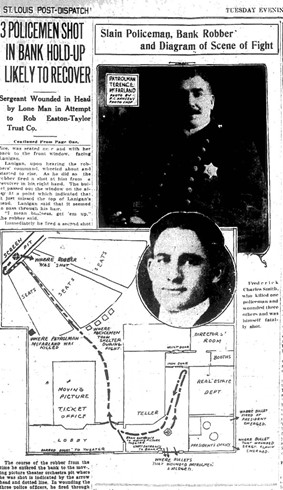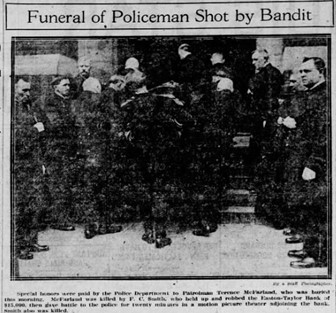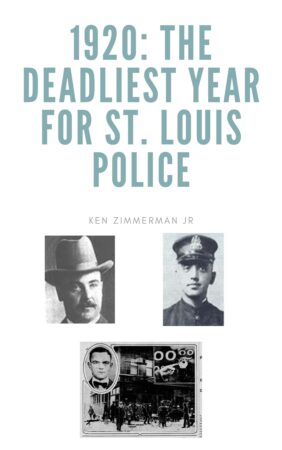Easton Taylor Trust Company Robbery
Nyob rau hnub tim 5, 1920, Frederick Charles Smith, los yog “Bandit uas muaj taws liab lub”, taug kev mus rau lub Easton-Taylor Trust tuam txhab ntawm 4474 Easton Avenue. Smith muaj ib phom me hauv txhua tes thiab uas cog noob nyiaj ntawm cov neeg khaws nyiaj. Fearing for his life, the clerk promptly dropped $15,309 nyob rau hauv ib lub hnab txhuv.
John Lanigan, the bank’s president, sat in his office off the lobby surveying the bank. He saw Smith enter the bank with a revolver in both hands.
Lanigan stood up to approach Smith, but Smith shot at him. Lanigan said it felt like the bullet went through his hair. Smith growled, “I mean business, get ‘em up.”

Article from April 6,1920 St. Louis Post-Dispatch about the Easton-Taylor Trust Robbery
Smith shot at customers and bank employees. Tsi, Smith missed everyone he shot at.
Smith herded customers and employees into Lanigan’s office. Customer Isabella Parker gently tapped on the glass of Lanigan’s office trying to attract attention from people on the outside of the Easton-Taylor Trust Company.
Parker attracted the attention of John J. Macklin, a feed and grain dealer. Macklin observed Smith with a gun in each hand and ran to the nearby Deer Street Station to summon the police.
Within minutes, fifty officers were descending on the bank. A victim of both terrible timing and poor planning, Smith robbed lub sij hawm thaum nyob 3:00 p.m. during shift change at the Deer Creek Police Station.
When Smith saw the police officers descending on the bank, Smith shot Sgt. W. L. Henry. The bullet struck Henry’s nose. Smith also shot Sgt. Flavin in the shoulder.
Smith fled into the Easton-Taylor Theater at 4472 Easton Avenue. The door from the bank lobby led to the lobby of the closed theater. Smith entered the theater and hid in the orchestra pit.
As the police officers entered the theater, Smith pib shooting ntawm nws txoj hauj lwm concealed. An unidentified officer carrying a riot gun accidentally shot Patrolman John Voss in the foot with a riot gun carried by another officer. Smith shot all the other officers.
Rau ib kis, Smith stood up in the pit and said, “Kuv zeem”. Smith held his hands above his head but still held a gun in each hand.
Officer Terence McFarland, who was crouching behind a stack of chairs next to the east wall, stood up and told Smith to drop his guns. Smith phom tuaj mus tua McFarland hauv siab. After Smith shot McFarland, the officers directed a withering volley of bullets on Smith’s position.
Tom qab ib pliag, the officers noticed Smith was not firing. Cov neeg khiav dej num ua tus orchestra qhov lawv txoj kev zoo. There they found Smith crumpled up on the floor with one gun in his hand and one on the piano. The officers quickly disarmed him and drug him out of the theater onto the sidewalk to await the ambulance.
Horrified school children saw the bloody Smith lie on the sidewalk for twenty minutes while waiting for the ambulance. St. Louis Police conveyed all the casualties to St. John lub tsev kho mob. Terence McFarland twb tuag. Smith tuag. Doctors expected all the other officers to survive.

Photo of Terence McFarland’s Funeral from the April 8, 1920 St. Louis Star thiab lub sij hawm
McFarland was approximately 41 xyoo. Even he did not know his date of birth. McFarland joined the police force on October 23, 1903. McFarland lived alone at 1128 Bayard Avenue. Smith’s bullet struck McFarland in the chest causing his death.
Smith was a strange case. He owned an electrical shop and invented a burglar alarm. Nws tus poj niam, Minnie Smith, described Smith as a “perfect husband.” She attributed his odd behavior to a brain injury.
Seven years earlier, a railroad accident concussed Smith. He suffered seizures after the accident.
Minnie said they had been married fourteen years. They lived in Dayton, Ohio until 1918. They moved to St. Louis living on Biddle Street before moving to the home and workshop in the 4100 block of Natural Bridge Avenue.
Thaum lub sijhawm tus nyiag, Frederick Charles Smith was negotiating with local businesspeople to sell his patented burglar alarm. Smith planned to sell his business in St. Louis so he and his wife could move back to Dayton.
On the day of the robbery, Smith spent the morning working on an electrical contract. Hais txog 1 tsaus ntuj, he told Minnie he was going to buy parts. He planned to be back in two hours and would call if he expected to be later.
Terence McFarland was the third member of his family to serve the St. Louis Police. Both of his brothers achieved the rank of Sergeant. They passed away before the murder of their brother in the line of duty.
His fourth brother, Luke McFarland, ib tug me nyuam. Louis firefighter, made the funeral arrangements for his brother.
Nyob rau hnub tim 7, 1920, Father Finan said the funeral mass for Terence McFarland at Church of the Visitation at N. Taylor and Evans Avenue. The funeral procession traveled to Calvary Cemetery for McFarland’s internment.
Minnie Smith arranged for Frederick C. Smith, Jr.’s burial in Valhalla, Cemetery. One of the bullets fired by the police struck Smith in the head. Smith died at 5 p.m. on the same day as Officer McFarland. After his funeral, Minnie Smith returned to Dayton, Ohio, where her brother and his family lived.
Armed criminals and an automobile killed three officers in 1920. Hmoov tsis, armed criminals and an automobile would kill five more officers before the year was out.
Koj yuav tawm ib saib los nug cov lus nug txog qhov no los yog tej tsev xa rau kuv Facebook phab los sis Twitter profile.
Qhov chaw: St. Louis Dispatch tom qab, Tim 6, 1920, p. 1 & 3, St. Louis Star thiab lub sij hawm, Tim 6, 1920, p. 2, St. Louis Star thiab lub sij hawm, Tim 8, 1920, p. 2, Frederick C. Smith, ❏ Jr ❏. Death Certificate, Missouri Death Certificate Database and Terence McFarland Death Certificate from the Missouri Death Certificate Database


